Bardia National Park, nestled in the Terai region of Nepal, stands as a beacon of hope and a sanctuary for some of the country’s most endangered wildlife. Spanning over 968 square kilometers, this protected area is home to breathtaking biodiversity including the elusive Bengal tiger and the critically endangered one-horned rhinoceros. As human activities and natural threats put pressure on this delicate ecosystem, dedicated conservation efforts have become essential to preserving Bardia’s unique flora and fauna. Let’s dive into the challenges faced by the park, explore the remarkable successes in protecting key species, and see how communities, authorities, and visitors all play a vital role in safeguarding Nepal’s natural treasures.
Conservation Challenges Facing Bardia
The journey of preserving Bardia National Park is not without its hurdles. One of the significant challenges is habitat loss and fragmentation driven by illegal logging, encroachment, and agricultural expansion. These activities shrink the territory available for wildlife and disrupt natural migration corridors, making it difficult for species to thrive. Poaching remains a grave threat, particularly for iconic animals like tigers and rhinos, targeted for their skins, horns, and other body parts in illegal wildlife trade networks.
Additionally, human-wildlife conflicts pose serious dilemmas. As local communities live adjacent to the park’s boundaries, encounters with wildlife—such as elephants raiding crops or tigers preying on livestock—can lead to retaliation and increased negative attitudes towards conservation efforts. Climate change further complicates the situation by altering rainfall patterns and water availability, which impacts both wildlife habitats and human livelihoods.
Key Species Protected and Recovery Success
Bardia is famous for its population of Bengal tigers, one of the largest and most important tiger habitats in Nepal. Thanks to rigorous anti-poaching patrols and habitat improvement projects, tiger numbers have gradually increased, reflecting a promising comeback. The one-horned rhinoceros, once on the brink of extinction in the region, has also made an encouraging recovery in Bardia due to focused conservation measures including intensive monitoring and protection efforts.
Beyond these flagship species, Bardia is home to elephants, swamp deer, wild boars, and a variety of birds and reptiles. This biodiversity richness is an indicator of the health of the ecosystem and the effectiveness of ongoing conservation work. Wild herbivore populations like chital and barasingha play a critical role in maintaining the ecological balance, supporting the food chain for apex predators like the tiger and leopard.
Role of Park Authorities and NGOs
The success of conservation in Bardia is rooted in the dedicated teamwork between the Nepalese Department of National Parks and Wildlife Conservation (DNPWC) and numerous non-governmental organizations (NGOs). The park authorities are responsible for policy enforcement, anti-poaching operations, and habitat management. They conduct regular wildlife surveys, maintain patrol posts, and implement strategies to mitigate human-wildlife conflict.
NGOs such as WWF Nepal, the National Trust for Nature Conservation (NTNC), and local community forest user groups complement governmental efforts. These organizations provide technical expertise, funding, and community outreach programs. They also assist in training rangers, conducting environmental education, and developing eco-tourism initiatives that promote sustainable interaction between humans and nature. This cooperation ensures that conservation strategies are holistic and inclusive.
Community Participation in Conservation
Local communities form the backbone of Bardia’s conservation successes. Recognizing that sustainable wildlife protection cannot occur without community support, various programs actively involve villagers in conservation activities. Community forest user groups contribute by managing buffer zones, reducing firewood dependency, and creating alternative income sources such as handicrafts and eco-tourism employment.
Human-wildlife conflict mitigation strategies often include compensation schemes for crop or livestock losses and the installation of protective measures like solar-powered fences and watchtowers. Through awareness campaigns and education, locals gain a stronger understanding of the ecological and economic benefits that a healthy park ecosystem provides. Empowering communities as active stakeholders creates a sense of pride and responsibility toward conserving their environment.
How Tourists Can Contribute Responsibly
Tourism plays a dual role in conservation by generating revenue and awareness, yet it must be practiced responsibly to avoid negative impacts. Visitors to Bardia National Park can support conservation efforts in several ways:
- Choose eco-friendly tour operators who prioritize low-impact activities and support local communities.
- Follow park rules such as staying on designated trails, not disturbing wildlife, and minimizing noise pollution.
- Respect local cultures and engage respectfully with community members to foster positive relationships.
- Contribute financially through park entry fees, donations, or participating in conservation volunteer programs.
- Avoid single-use plastics and carry reusable water bottles to help maintain the park’s pristine environment.
By embracing these responsible behaviors, tourists help ensure that Bardia remains a thriving habitat for generations to come while enriching their own travel experience.
Future Outlook for Bardia’s Ecosystem
Looking ahead, the future of Bardia National Park hinges on enhanced collaboration, adaptive management, and continued community involvement. Strengthening transboundary cooperation with India’s neighboring protected areas is a crucial step to creating larger wildlife corridors and increasing genetic diversity among species like tigers and elephants.
Investment in research, monitoring technology such as camera traps and GPS collars, and anti-poaching intelligence capabilities will further empower conservationists. Additionally, expanding environmental education programs for youth and advocating for sustainable land-use practices within the region will safeguard both biodiversity and human well-being.
Climate resilience strategies, including reforestation and water conservation projects, are also vital to mitigate the effects of changing weather patterns on Bardia’s landscapes and inhabitants. With a comprehensive and adaptive approach, this remarkable ecosystem can continue to flourish as a model of successful wildlife conservation.
Protecting Nepal’s Natural Treasures
Bardia National Park is more than just a protected area—it’s a living testament to the power of dedicated conservation combined with the harmony between nature and people. From the stealthy Bengal tiger prowling dense forests to local communities embracing sustainable livelihoods, Bardia exemplifies how diverse stakeholders can unite to preserve natural heritage. By understanding the challenges, appreciating the successes, and supporting ongoing efforts, each of us can contribute to ensuring that this vital sanctuary remains a vibrant refuge for wildlife and a source of inspiration for conservation worldwide.







